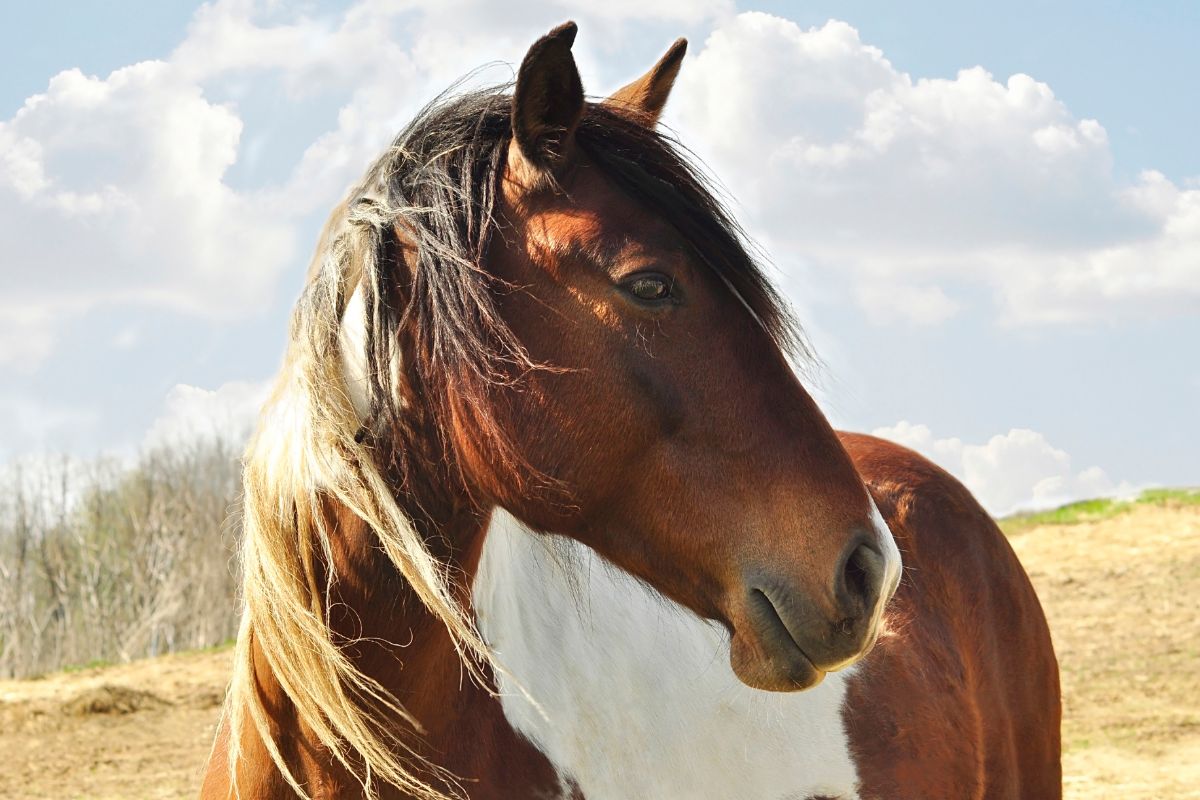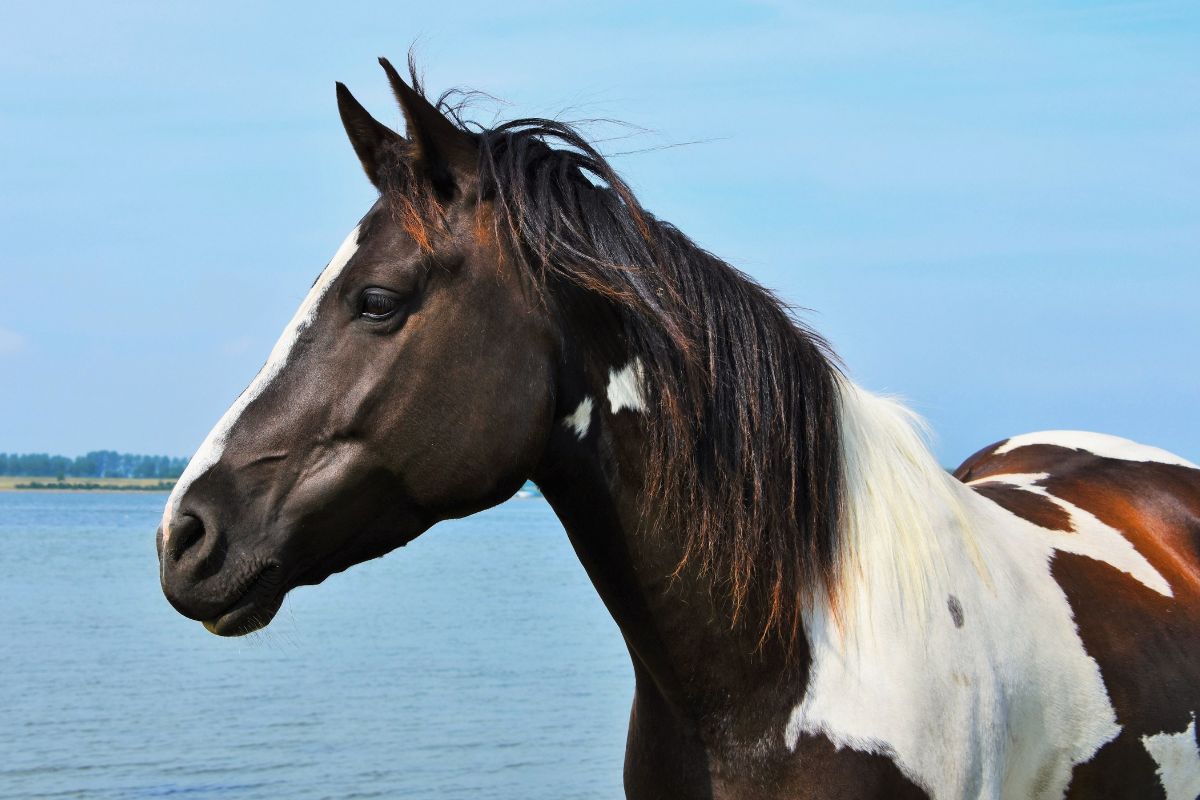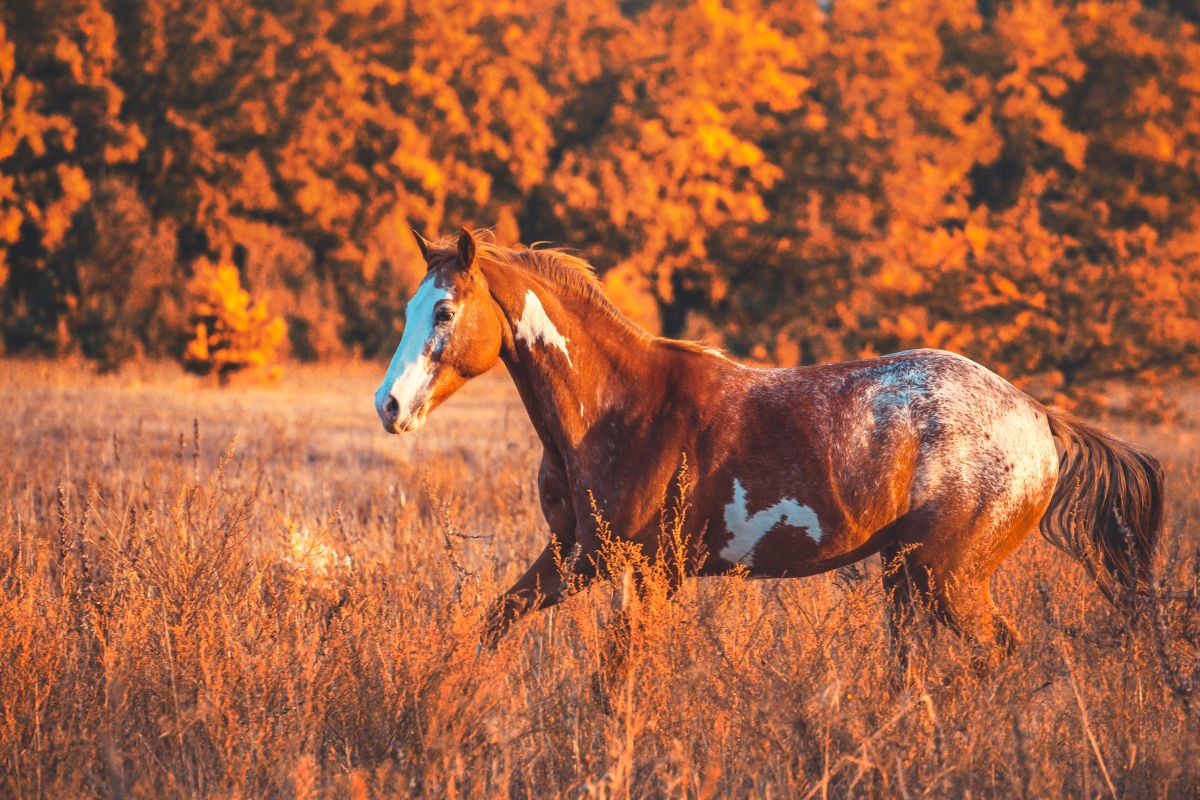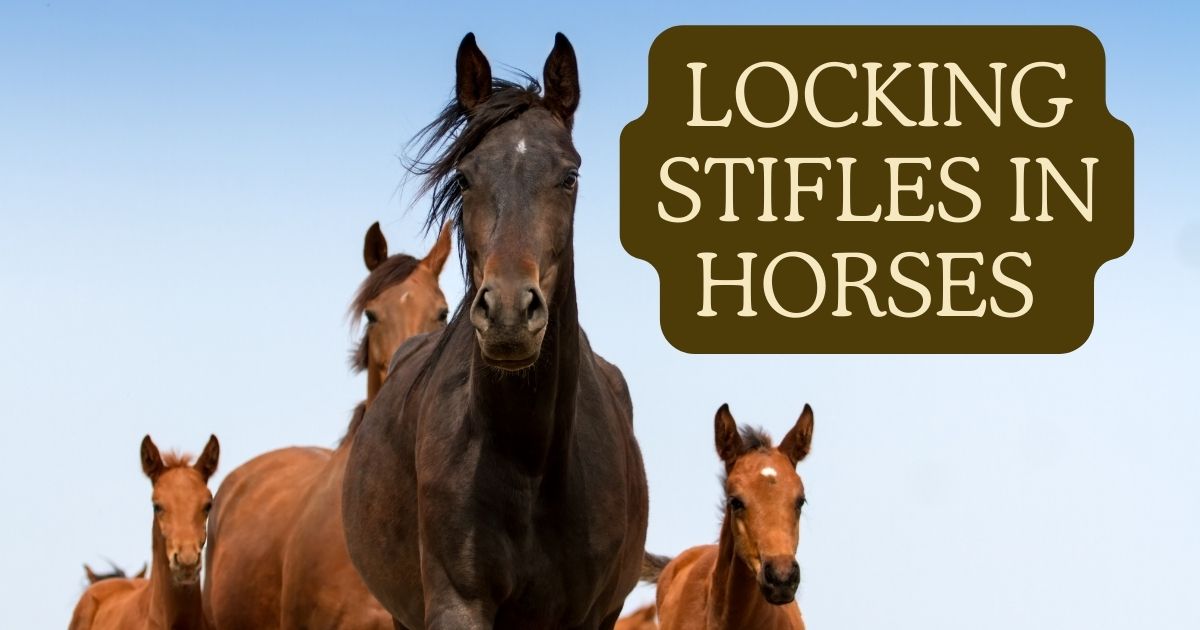What is a Locking Stifle on a Horse?
Many horse owners ask themselves, what is a stifle on a horse? Locking stifles in horses is a condition often perplexing to owners and refers to a temporary inability to flex the stifle joint, equivalent to the human knee.
This joint, where the hind leg meets the body, houses the horse’s patella. In a locking stifle, the patella gets stuck, preventing normal movement.
Common in young, inactive, or conformationally predisposed horses, this condition can cause noticeable hind leg stiffness, often alarming but usually not painful.
Causes of Locked Stifle in Horses
A locked stifle, clinically known as upward fixation of the patella (UFP), is a notable condition in horses where the patella, or kneecap, gets “locked” over the medial ridge of the femur.
This prevents the normal sliding movement of the patella, where the hind leg joins the body. Several factors contribute to this condition, intertwining anatomical, physiological, and developmental aspects.
One primary cause for a horse locking stifle is underdeveloped muscles in the hindquarters, particularly in young or inactive horses. This lack of muscle tone can lead to an imbalance in the stifle mechanism, making it easier for the patella to lock. Additionally, horses with certain conformational traits, such as straight hind limb conformation, are more predisposed to developing a locking stifle.
Nutritional imbalances, particularly in growing horses, can also play a role. An inadequate or imbalanced diet may lead to developmental orthopedic diseases, indirectly contributing to stifle issues. Furthermore, specific medical conditions, like joint inflammation or trauma to the stifle area, can exacerbate the risk of a locking patella.
Interestingly, while locking stifle can be a concern for horse owners, it’s often not associated with pain in the horse. However, it can lead to irregular gait patterns and potential falls, posing a risk for the horse and rider. In severe cases, stifle surgery might be considered as a treatment option.
Horse owners must consult a veterinarian to diagnose and manage this condition accurately, especially when considering riding a horse with stifle problems.

Symptoms of Locking Stifles in Horses
Locking stifles in horses manifest through various symptoms, which are pivotal for timely identification and management. The stifle, a complex joint analogous to the human knee, is located where the horse’s hind leg connects to the body. In UFP, the patella (kneecap) gets caught on the femur’s medial ridge, disrupting normal leg movement.
One of the most conspicuous symptoms is an intermittent dragging of the toe of the hind leg or a sudden hitching up of the limb. This occurs because the locked patella impedes the horse’s ability to flex the stifle, leading to a characteristic straight-legged gait. This gait irregularity is more evident when the horse moves from a standing position or when walking uphill.
Occasionally, the horse may abruptly halt in its stride, followed by a snapping sound as the patella releases and normal movement resumes. Sometimes, the horse might appear momentarily stuck in place, struggling to move forward.
Muscle atrophy in the hindquarters can also be a subtle symptom of chronic stifle issues. This muscle wasting results from reduced use of the affected limb due to discomfort or mechanical limitations caused by the locking patella.
While not typically painful, locked stifles in horses can cause noticeable discomfort and anxiety, especially when the locking episodes become frequent or prolonged. Owners must observe these symptoms closely, as they can impact the horse’s performance and well-being.
Consulting a veterinarian is crucial for a proper diagnosis, especially in cases where stifle surgery is a treatment option. Early intervention can prevent progression and aid in better management of this condition.
Diagnosing Locking Stifles in Horses
Diagnosing locking stifles in horses, also known as upward fixation of the patella, requires a thorough veterinary assessment, integrating clinical observation with diagnostic techniques.
Initial diagnosis often begins with a detailed history and observation of the horse’s gait.
Veterinarians look for characteristic signs such as a straight-legged gait, toe dragging, or the horse’s inability to flex the stifle joint. The sudden release of the locked patella, sometimes accompanied by a noticeable clicking sound, is a crucial indicator.
Palpation of the stifle area can provide additional insights. The veterinarian may manipulate the patella to assess its movement and check for any signs of pain, swelling, or other abnormalities in the stifle joint.
Advanced imaging techniques like radiography (X-rays) can rule out other stifle joint pathologies like osteoarthritis or fractures. In some cases, ultrasonography is an essential tool to evaluate the soft tissue structures around the stifle, including the ligaments and tendons.
Diagnosing a horse with a locking stifle involves identifying the mechanical issue and understanding its underlying causes.
Once the veterinarian points out a diagnosis, treatment options vary based on the severity and underlying cause. These can range from exercise regimens to strengthen the hindquarters, dietary adjustments, medical management, and, in severe cases, stifle surgery.
Horse owners must work closely with their veterinarians to develop an effective treatment plan, ensuring their health and functionality are optimally maintained.
How to Treat Locking Patellas in Equines
Treating locking patellas in equines involves a multifaceted approach, integrating conservative management and surgical interventions.
Conservative Management
The initial line of treatment often includes exercise and physical therapy. Increasing activity can be beneficial, particularly exercises that strengthen the muscles of the hindquarters. Controlled exercises like hill work, trotting, and lunging help enhance muscle tone, reducing the incidence of patella locking.
In addition to physical therapy, weight management is crucial. Overweight horses may experience increased stress on their stifle joints, exacerbating the symptoms. A balanced diet, tailored to the horse’s specific needs, can aid in maintaining an optimal weight.
Medical Management
Veterinarians may prescribe anti-inflammatory medications to reduce swelling and discomfort in the stifle area. When muscle tension contributes to UFP, muscle relaxants prove beneficial.
Veterinarian-Recommended Supplements
Dietary supplements can play a supportive role in managing locking patellas. Ingredients like glucosamine and chondroitin sulfate are crucial for joint health. These components aid in maintaining cartilage health and joint fluid viscosity.
Omega-3,6,9 fatty acids are known for their potent anti-inflammatory properties and can be very beneficial. Vitamin E and selenium are antioxidants that support muscle health, potentially aiding in preventing muscle atrophy associated with UFP.
Table of Supplement Ingredients and Their Benefits
| Ingredient | Benefits |
| Glucosamine | Supports cartilage health |
| Chondroitin sulfate | Maintains joint fluid viscosity |
| Omega-3 fatty acids | Reduces inflammation |
| Vitamin E | Antioxidant, supports muscle health |
| Selenium | Antioxidant, prevents muscle atrophy |
Surgical Interventions
In cases where conservative and medical management fail to provide relief, surgical options are a path to recovery. The most common surgical procedure for locking stifles in horses is a medial patellar ligament splitting.
This technique involves making minor, strategic cuts in the medial patellar ligament, reducing the likelihood of the patella becoming caught on the femur’s medial ridge.
This procedure has a high success rate, with many horses returning to full activity.
Another surgical option, though less common, is medial patellar ligament desmotomy. This involves cutting the ligament entirely, a more invasive procedure typically reserved for severe cases.
Post-Surgical Care
Critical post-operative care ensures a successful outcome. It begins with a rest period, then gradually reintroduces exercise. Continuation or intensification of physical therapy may strengthen the stifle joint and prevent recurrence,
Monitoring and Ongoing Care
Regularly monitoring the horse’s condition is essential, regardless of the treatment method.
Owners should observe their horse’s gait and report any signs of recurrence to their veterinarian. Regular veterinary check-ups can help assess the treatment plan’s effectiveness and make necessary adjustments.
In conclusion, treating locking patellas in horses requires a comprehensive approach, combining exercise, dietary management, possible supplementation, medical treatment, and, in some cases, surgical intervention.
Collaboration between the horse owner and veterinarian is vital to ensure the best outcome for the equine patient.

Locking Stifle Exercises for Horses
Effective management of this condition often involves a targeted exercise regimen to strengthen the muscles surrounding the stifle joint, improve flexibility, and enhance overall hind limb function.
Hill Work
This is one of the most beneficial exercises for horses with a locking stifle. Walking and trotting up and down gentle slopes helps strengthen the hindquarters and stifle muscles. The upward movement encourages the horse to lift its hind legs higher, promoting flexibility and strength in the stifle joint.
Care should be taken to start with shallow slopes, gradually increasing the incline as the horse builds strength.
Cavaletti Work
Guiding the horse over a series of low rails set at specific distances apart constitutes Cavaletti exercises. These exercises encourage the horse to lift its legs, thus enhancing joint mobility and muscle strength in the hindquarters. Based on the horse’s ability and progression, trainers can adjust the height and spacing of the cavaletti.
Lunging
Lunging, especially in a large circle, can be effective for horses with UFP. It encourages consistent movement and builds muscle tone. The circular motion requires the horse to balance and shift its weight, which can help improve joint stability.
However, you should avoid excessive tight circling, as it can place additional stress on the stifle joint.
Backing Exercises
Backing the horse up several steps daily can significantly help strengthen the stifle area. This exercise requires the horse to engage its hindquarters and lift the hind legs, providing targeted muscle work for its patella.
Stretching Exercises
Stretching is crucial for maintaining flexibility in the stifle joint. Leg stretches, where the hind leg is gently and safely extended backward, can help increase the range of motion.
You should perform these under the guidance of a veterinarian or an equine physiotherapist to ensure correct and safe execution.
Targeted Groundwork
Simple groundwork exercises, such as leading the horse in various patterns and over different terrains, can also be beneficial. These exercises build muscle and improve coordination and proprioception, which are essential for joint health.
Swimming
For horses, swimming is an excellent low-impact exercise that can strengthen the entire body, including the stifle muscles, without putting undue stress on the joints. This can be particularly beneficial for rehabilitation after stifle surgery in horses.
Controlled Turnout
While rest is essential, prolonged inactivity can worsen a locking stifle. Controlled turnout in a safe, enclosed area allows the horse to move freely, promoting muscle tone and joint health. Monitoring the horse during turnout is vital to ensure it does not engage in excessive or sudden movements that might exacerbate the condition.
Tailored Exercise Plan
A tailored exercise plan should be developed in consultation with a veterinarian or an equine rehabilitation specialist. The plan should consider the horse’s overall health, severity of UFP, and response to previous exercises.
Regular assessments and adjustments to the exercise regimen are crucial for effectively managing locking stifles.
In summary, managing locking stifles in horses requires a comprehensive exercise program encompassing strength training, flexibility, and controlled movement. Customize exercise plans according to each horse’s unique situation.
Regular veterinary check-ups are of the essence to monitor the horse’s progress and adjust the exercise regimen as needed. With proper management, most horses with locking stifles can maintain a good quality of life and, in many cases, continue their usual activities.
The Prognosis
The prognosis of locking stifles in horses varies depending on several factors, including the severity of the condition, underlying causes, and the response to treatment.
In many cases, especially when diagnosed early, the prognosis for horses with locking stifles is generally good. Young horses often outgrow the condition as they develop and strengthen their hindquarter muscles. For these younger equines, conservative management involving a tailored exercise regimen, including hill work and cavaletti exercises, can be highly effective.
The outlook is also favorable for horses where the condition is due to a lack of muscle tone or conditioning. Here, strengthening and conditioning exercises, alongside proper nutrition, can lead to significant improvements.
However, the prognosis can be more guarded in horses with conformational predispositions or in chronic cases with muscle atrophy. These cases may require more intensive management, including possible surgical intervention.
Surgical procedures, such as medial patellar ligament splitting or desmotomy, have high success rates, but they also involve a period of rehabilitation and careful post-operative care.
It’s important to note that even with successful treatment, some horses may experience occasional recurrences, particularly if they undergo periods of reduced activity or if their muscle tone decreases.
Regular veterinary assessments and adherence to a structured management plan are crucial in optimizing horses’ outcomes with locking stifles. With appropriate care, most horses can lead active, comfortable lives.
However, owners should be aware of the potential for ongoing maintenance and possible adjustments in the horse’s workload or activity level based on their individual response to treatment.
Can You Ride a Horse With Stifle Problems?
Riding a horse with stifle problems, a common concern among equine enthusiasts requires careful consideration and a nuanced understanding of the condition’s nature and severity. The stifle joint is critical to a horse’s hind limb movement.
The decision to ride a horse with stifle problems hinges on several factors:
Severity and Stage of the Condition
For mild cases of UFP or other stifle issues, riding may still be possible, especially if the horse responds well to treatment and management strategies. In these instances, the riding exercise can be beneficial, as it helps strengthen the muscles supporting the stifle joint.
Veterinary Advice
A veterinarian’s assessment is crucial. Considering the specific stifle issue, they can guide the owner on their horse’s capabilities and limitations. The veterinarian might recommend a modified riding schedule or specific exercises that benefit the horse.
Type of Riding
The intensity and type of riding are significant factors. Light, gentle riding on flat terrain may be permissible for some horses with stifle issues. However, demanding activities like jumping, sharp turns, or competitive events might be too stressful on the affected stifle joint.
Response to Treatment
If the horse is undergoing treatment for stifle problems, such as physical therapy, medication, or post-surgical rehabilitation, its response to these interventions will dictate the suitability of riding. Horses that show improvement and decreased symptoms may gradually return to riding under close supervision.
Horse’s Comfort and Behavior
It is essential to monitor the horse’s comfort and behavior. If the horse shows signs of discomfort, reluctance to move, or irregular gait patterns while being ridden, this may indicate that tiding exacerbates the stifle issue.
Ongoing Monitoring
Regular veterinary check-ups to monitor the progression or improvement of the stifle condition are vital. These check-ins help assess whether continued riding is advisable.
In summary, while riding a horse with stifle problems is not outrightly contraindicated, it demands a cautious, well-informed approach.
The welfare and comfort of the horse must always be the primary concern. Adjustments to riding routines, ongoing veterinary supervision, and a keen awareness of the horse’s comfort levels are imperative in making responsible decisions about riding a horse with stifle issues.
Do Horses Have Kneecaps?
Yes, horses do have kneecaps. The kneecap, or patella, is a crucial component in a horse’s stifle joint anatomy, which is functionally analogous to the human knee. The stifle joint is a complex structure located at the point where the horse’s hind leg meets the body, playing a vital role in the horse’s ability to move, bear weight, and perform various activities.
The patella, embedded within the tendon of the quadriceps muscle, the major muscle group of the horse’s thigh, primarily protects the front of the joint. It facilitates smooth leg movement by sliding over the joint during motion.
Anatomically, the patella sits in a spot called the trochlear groove, found at the lower end of the femur (thighbone). The patella’s movement within this groove is essential for flexing and extending the stifle joint. Ligaments attach the patella to the femur and the tibia (shinbone), providing stability to the joint.
The patella also plays a role in the locking mechanism of the stifle joint. This unique feature allows horses to lock their hind limbs while standing, enabling them to rest without collapsing.
However, when this locking mechanism malfunctions, it can lead to conditions like upward fixation of the patella (UFP), causing the patella to temporarily lock over the medial ridge of the femur, affecting the horse’s movement.
Understanding the anatomy and function of the horse’s patella is crucial in effectively diagnosing and managing stifle-related issues.
Would You Buy a Horse With a Locking Stifle?
Prospective buyers should seek a thorough veterinary examination to understand the severity and manageability of the condition. It’s crucial to evaluate how locking stifle affects the horse’s intended use, whether for riding, competition, or leisure.
Additionally, consider the potential long-term care needs, including exercise regimen, possible medical treatments, and the financial and time commitments for ongoing management. A well-informed decision ensures the well-being of both the horse and the owner.
Which Horses Are Most At Risk?
Locking stifle can affect horses of various breeds, but some are more predisposed to this condition due to genetic, conformational, and physiological factors. Typically, horse breeds with certain conformational traits are at a higher risk for developing UFP.
Draft Breeds
Large draft breeds like Clydesdales, Belgians, and Percherons are often more prone to locking stifle. Their substantial body mass and unique conformation, characterized by straighter hind limb angles, can strain the stifle joint more. This strain may increase the likelihood of the patella locking over the medial ridge of the femur.
Ponies and Small Horse Breeds
Ponies and smaller horse breeds, including Shetland Ponies and Icelandic horses, also have a higher incidence of locking stifles. Their compact body structure and shorter limbs can predispose them to this condition, particularly if they have a straight stifle conformation.
Young, Growing Horses
Regardless of breed, young and growing horses are at a heightened risk for UFP. During their growth phases, these horses may experience periods of rapid growth, leading to muscle and structural imbalances around the stifle joint. This imbalance can temporarily contribute to the locking of the patella.
Horses With Poor Muscle Tone
Horses of any breed with underdeveloped hindquarters or poor overall muscle tone are more susceptible to stifle issues. This issue is often seen in horses not regularly exercised or recovering from an extended rest period due to illness or injury.
While these breeds and categories may be more at risk, locking stifle can occur in any horse. Regular exercise, proper nutrition, and close monitoring of growth and development in young horses are vital preventive measures.
For owners of at-risk breeds, being vigilant about the signs of UFP and seeking timely veterinary advice is crucial for early intervention and effective management.

Can Locking Stifle in Horses be Prevented?
Preventing locking stifle in horses involves addressing the various factors contributing to this condition. While not all cases are preventable, especially due to genetic predisposition or conformational traits, specific measures can reduce the risk.
Regular exercise is paramount in avoiding UFP. Exercises that strengthen the hindquarters and improve overall muscle tone are particularly beneficial. These include hill work, cavaletti exercises, and controlled lunging. These activities enhance the strength and flexibility of the muscles surrounding the stifle joint, reducing the likelihood of the patella locking.
Proper nutrition can be crucial in maintaining healthy muscle and joint function. A balanced diet, tailored to the horse’s age, breed, and activity level, supports optimal growth and development, especially in young, growing horses.
Routine veterinary check-ups are also essential. Regular assessments can identify early signs of stifle issues, allowing for prompt intervention. This is especially important for breeds or individuals predisposed to UFP.
While complete prevention may not be feasible, these strategies can significantly minimize the risk and impact of locking stifles in horses, contributing to their overall health and performance.
Parting Words
Locking stifle in horses is a condition where the patella temporarily shuts over the medial ridge of the femur, affecting the stifle joint’s normal movement. Certain breeds, like draft horses and ponies, are more prone to this issue, which factors such as conformation, muscle development, and age can influence.
Symptoms include irregular gait and hind leg stiffness, with diagnosis involving veterinary examination and possibly imaging. Treatment varies from exercise and weight management to surgical interventions in severe cases.
Preventative measures include regular exercise to strengthen hindquarters, proper nutrition, and routine veterinary check-ups, especially for at-risk breeds. While young and growing horses may outgrow this condition, horse owners must know the signs and seek timely veterinary advice.
With appropriate management, most horses with locking stifles can lead active, comfortable lives.
